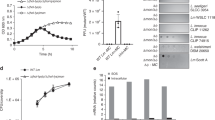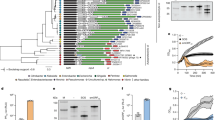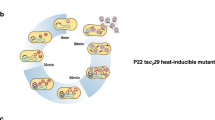Abstract
Unlike lytic phages, temperate phages that enter lysogeny maintain a long-term association with their bacterial host. In this context, mutually beneficial interactions can evolve that support efficient reproduction of both phages and bacteria. Temperate phages are integrated into the bacterial chromosome as large DNA insertions that can disrupt gene expression, and they may pose a fitness burden on the cell. However, they have also been shown to benefit their bacterial hosts by providing new functions in a bacterium–phage symbiotic interaction termed lysogenic conversion. In this Opinion article, we discuss another type of bacterium–phage interaction, active lysogeny, in which phages or phage-like elements are integrated into the bacterial chromosome within critical genes or operons and serve as switches that regulate bacterial genes via genome excision.
This is a preview of subscription content, access via your institution
Access options
Subscribe to this journal
Receive 12 print issues and online access
$209.00 per year
only $17.42 per issue
Buy this article
- Purchase on Springer Link
- Instant access to full article PDF
Prices may be subject to local taxes which are calculated during checkout




Similar content being viewed by others
References
Twort, F. W. An investigation on the nature of ultra-microscopic viruses. Lancet 186, 1241–1243 (1915).
d'Herelle, F. An invisible microbe that is antagonistic to the dysentery Bacillus. Compt. Rend. Acad. Sci. Paris 165, 373–375 (1917).
Pawluk, A., Bondy-Denomy, J., Cheung, V. H., Maxwell, K. L. & Davidson, A. R. A new group of phage anti-CRISPR genes inhibits the type I-E CRISPR–Cas system of Pseudomonas aeruginosa. mBio 5, e00896 (2014).
Bobay, L. M., Touchon, M. & Rocha, E. P. Pervasive domestication of defective prophages by bacteria. Proc. Natl Acad. Sci. USA 111, 12127–12132 (2014).
Labrie, S. J., Samson, J. E. & Moineau, S. Bacteriophage resistance mechanisms. Nat. Rev. Microbiol. 8, 317–327 (2010).
Stern, A. & Sorek, R. The phage-host arms race: shaping the evolution of microbes. Bioessays 33, 43–51 (2011).
Breitbart, M. & Rohwer, F. Here a virus, there a virus, everywhere the same virus? Trends Microbiol. 13, 278–284 (2005).
Brussow, H. & Hendrix, R. W. Phage genomics: small is beautiful. Cell 108, 13–16 (2002).
Ptashne, M. A Genetic Switch 3rd edn (CSHL Press, 2004).
Edlin, G., Lin, L. & Bitner, R. Reproductive fitness of P1, P2, and Mu lysogens of Escherichia coli. J. Virol. 21, 560–564 (1977).
Ravin, V. et al. Genomic sequence and analysis of the atypical temperate bacteriophage N15. J. Mol. Biol. 299, 53–73 (2000).
Little, J. in Regulation of Gene Expression in Escherichia coli (eds Lin, E. C. C. & Lynch, A. S.) 453–479 (Springer US, 1996).
Lwoff, A. Lysogeny. Bacteriol. Rev. 17, 269–337 (1953).
Nanda, A. M., Thormann, K. & Frunzke, J. Impact of spontaneous prophage induction on the fitness of bacterial populations and host–microbe interactions. J. Bacteriol. 197, 410–419 (2015).
Nash, H. A. Integration and excision of bacteriophage λ: the mechanism of conservation site specific recombination. Annu. Rev. Genet. 15, 143–167 (1981).
Shimada, K., Weisberg, R. A. & Gottesman, M. E. Prophage lambda at unusual chromosomal locations: I. Location of the secondary attachment sites and the properties of the lysogens. J. Mol. Biol. 63, 483–503 (1972).
Harshey, R. M. The Mu story: how a maverick phage moved the field forward. Mob. DNA 3, 21 (2012).
Miller, R. V. & Ripp, S. A. in Horizontal Gene Transfer (eds Syvanen, M. & Kado, C. I.) 81–94 (Academic Press, 2001).
Baess, I. Report on a pseudolysogenic mycobacterium and a review of the literature concerning pseudolysogeny. Acta Pathol. Microbiol. Scand. B Microbiol. Immunol. 79, 428–434 (1971).
Miller, R. & Day, M. in Bacteriophage Ecology (ed Abedon, S. T.) 114–144 (Cambridge Univ. Press, 2008).
Fuhrman, J. A. Marine viruses and their biogeochemical and ecological effects. Nature 399, 541–548 (1999).
Suttle, C. A. & Chen, F. Mechanisms and rates of decay of marine viruses in seawater. Appl. Environ. Microbiol. 58, 3721–3729 (1992).
Hartley, M. A., Ronet, C. & Fasel, N. Backseat drivers: the hidden influence of microbial viruses on disease. Curr. Opin. Microbiol. 15, 538–545 (2012).
Wagner, P. L. & Waldor, M. K. Bacteriophage control of bacterial virulence. Infect. Immun. 70, 3985–3993 (2002).
Brussow, H., Canchaya, C. & Hardt, W. D. Phages and the evolution of bacterial pathogens: from genomic rearrangements to lysogenic conversion. Microbiol. Mol. Biol. Rev. 68, 560–602 (2004).
Casjens, S. Prophages and bacterial genomics: what have we learned so far? Mol. Microbiol. 49, 277–300 (2003).
Frobisher, M. & Brown, J. Transmissible toxicogenicity of Streptococci. Bull. Johns Hopkins Hosp. 41, 167–173 (1927).
Freeman, V. J. Studies on the virulence of bacteriophage-infected strains of Corynebacterium diphtheriae. J. Bacteriol. 61, 675–688 (1951).
Fujii, N., Oguma, K., Yokosawa, N., Kimura, K. & Tsuzuki, K. Characterization of bacteriophage nucleic acids obtained from Clostridium botulinum types C and D. Appl. Environ. Microbiol. 54, 69–73 (1988).
Barksdale, L. & Arden, S. B. Persisting bacteriophage infections, lysogeny, and phage conversions. Annu. Rev. Microbiol. 28, 265–299 (1974).
Plunkett, G. 3rd, Rose, D. J., Durfee, T. J. & Blattner, F. R. Sequence of Shiga toxin 2 phage 933W from Escherichia coli O157:H7: Shiga toxin as a phage late-gene product. J. Bacteriol. 181, 1767–1778 (1999).
Waldor, M. K. & Mekalanos, J. J. Lysogenic conversion by a filamentous phage encoding cholera toxin. Science 272, 1910–1914 (1996).
Faruque, S. M., Albert, M. J. & Mekalanos, J. J. Epidemiology, genetics, and ecology of toxigenic Vibrio cholerae. Microbiol. Mol. Biol. Rev. 62, 1301–1314 (1998).
Mirold, S. et al. Isolation of a temperate bacteriophage encoding the type III effector protein SopE from an epidemic Salmonella typhimurium strain. Proc. Natl Acad. Sci. USA 96, 9845–9850 (1999).
Coleman, D. C. et al. Staphylococcus aureus bacteriophages mediating the simultaneous lysogenic conversion of β-lysin, staphylokinase and enterotoxin A: molecular mechanism of triple conversion. J. Gen. Microbiol. 135, 1679–1697 (1989).
Muhldorfer, I. et al. Regulation of the Shiga-like toxin II operon in Escherichia coli. Infect. Immun. 64, 495–502 (1996).
Wagner, P. L. et al. Role for a phage promoter in Shiga toxin 2 expression from a pathogenic Escherichia coli strain. J. Bacteriol. 183, 2081–2085 (2001).
Livny, J. & Friedman, D. I. Characterizing spontaneous induction of Stx encoding phages using a selectable reporter system. Mol. Microbiol. 51, 1691–1704 (2004).
Reidl, J. & Klose, K. E. Vibrio cholerae and cholera: out of the water and into the host. FEMS Microbiol. Rev. 26, 125–139 (2002).
de Kievit, T. R. & Iglewski, B. H. Bacterial quorum sensing in pathogenic relationships. Infect. Immun. 68, 4839–4849 (2000).
Dunny, G. M. & Leonard, B. A. Cell–cell communication in Gram-positive bacteria. Annu. Rev. Microbiol. 51, 527–564 (1997).
Waldor, M. K. & Friedman, D. I. Phage regulatory circuits and virulence gene expression. Curr. Opin. Microbiol. 8, 459–465 (2005).
Casas, V. & Maloy, S. Role of bacteriophage-encoded exotoxins in the evolution of bacterial pathogens. Future Microbiol. 6, 1461–1473 (2011).
McShan, W. M., Tang, Y. F. & Ferretti, J. J. Bacteriophage T12 of Streptococcus pyogenes integrates into the gene encoding a serine tRNA. Mol. Microbiol. 23, 719–728 (1997).
Williams, K. P. Integration sites for genetic elements in prokaryotic tRNA and tmRNA genes: sublocation preference of integrase subfamilies. Nucleic Acids Res. 30, 866–875 (2002).
Dubnau, D. DNA uptake in bacteria. Annu. Rev. Microbiol. 53, 217–244 (1999).
Grossman, A. D. Genetic networks controlling the initiation of sporulation and the development of genetic competence in Bacillus subtilis. Annu. Rev. Genet. 29, 477–508 (1995).
Claverys, J. P., Prudhomme, M. & Martin, B. Induction of competence regulons as a general response to stress in Gram-positive bacteria. Annu. Rev. Microbiol. 60, 451–475 (2006).
Borezee, E., Msadek, T., Durant, L. & Berche, P. Identification in Listeria monocytogenes of MecA, a homologue of the Bacillus subtilis competence regulatory protein. J. Bacteriol. 182, 5931–5934 (2000).
Loessner, M. J., Inman, R. B., Lauer, P. & Calendar, R. Complete nucleotide sequence, molecular analysis and genome structure of bacteriophage A118 of Listeria monocytogenes: implications for phage evolution. Mol. Microbiol. 35, 324–340 (2000).
Klumpp, J. & Loessner, M. J. Listeria phages: genomes, evolution, and application. Bacteriophage 3, e26861 (2013).
Zink, R. & Loessner, M. J. Classification of virulent and temperate bacteriophages of Listeria spp. on the basis of morphology and protein analysis. Appl. Environ. Microbiol. 58, 296–302 (1992).
Loessner, M. J., Wendlinger, G. & Scherer, S. Heterogeneous endolysins in Listeria monocytogenes bacteriophages: a new class of enzymes and evidence for conserved holin genes within the siphoviral lysis cassettes. Mol. Microbiol. 16, 1231–1241 (1995).
Rabinovich, L., Sigal, N., Borovok, I., Nir-Paz, R. & Herskovits, A. A. Prophage excision activates Listeria competence genes that promote phagosomal escape and virulence. Cell 150, 792–802 (2012).
Hamon, M., Bierne, H. & Cossart, P. Listeria monocytogenes: a multifaceted model. Nat. Rev. Microbiol. 4, 423–434 (2006).
Rosenberg, S. M. Evolving responsively: adaptive mutation. Nat. Rev. Genet. 2, 504–515 (2001).
LeClerc, J. E., Li, B., Payne, W. L. & Cebula, T. A. High mutation frequencies among Escherichia coli and Salmonella pathogens. Science 274, 1208–1211 (1996).
Jolivet-Gougeon, A. et al. Bacterial hypermutation: clinical implications. J. Med. Microbiol. 60, 563–573 (2011).
Scott, J., Nguyen, S. V., King, C. J., Hendrickson, C. & McShan, W. M. Phage-like Streptococcus pyogenes chromosomal islands (SpyCI) and mutator phenotypes: control by growth state and rescue by a SpyCI-encoded promoter. Front. Microbiol. 3, 317 (2012).
Novick, R. P., Christie, G. E. & Penades, J. R. The phage-related chromosomal islands of Gram-positive bacteria. Nat. Rev. Microbiol. 8, 541–551 (2010).
Scott, J., Thompson-Mayberry, P., Lahmamsi, S., King, C. J. & McShan, W. M. Phage-associated mutator phenotype in group A Streptococcus. J. Bacteriol. 190, 6290–6301 (2008).
Canchaya, C. et al. Genome analysis of an inducible prophage and prophage remnants integrated in the Streptococcus pyogenes strain SF370. Virology 302, 245–258 (2002).
Nguyen, S. V. & McShan, W. M. Chromosomal islands of Streptococcus pyogenes and related streptococci: molecular switches for survival and virulence. Front. Cell. Infect. Microbiol. 4, 109 (2014).
Kimura, T., Amaya, Y., Kobayashi, K., Ogasawara, N. & Sato, T. Repression of sigK intervening (skin) element gene expression by the CI-like protein SknR and effect of SknR depletion on growth of Bacillus subtilis cells. J. Bacteriol. 192, 6209–6216 (2010).
Stragier, P., Kunkel, B., Kroos, L. & Losick, R. Chromosomal rearrangement generating a composite gene for a developmental transcription factor. Science 243, 507–512 (1989).
Kunkel, B., Losick, R. & Stragier, P. The Bacillus subtilis gene for the development transcription factor sigma K is generated by excision of a dispensable DNA element containing a sporulation recombinase gene. Genes Dev. 4, 525–535 (1990).
Takemaru, K., Mizuno, M., Sato, T., Takeuchi, M. & Kobayashi, Y. Complete nucleotide sequence of a skin element excised by DNA rearrangement during sporulation in Bacillus subtilis. Microbiology 141, 323–327 (1995).
Sato, T. & Kobayashi, Y. The ars operon in the skin element of Bacillus subtilis confers resistance to arsenate and arsenite. J. Bacteriol. 180, 1655–1661 (1998).
Silvaggi, J. M., Perkins, J. B. & Losick, R. Small untranslated RNA antitoxin in Bacillus subtilis. J. Bacteriol. 187, 6641–6650 (2005).
Yamaguchi, Y., Park, J. H. & Inouye, M. Toxin-antitoxin systems in bacteria and archaea. Annu. Rev. Genet. 45, 61–79 (2011).
Hayes, F. & Kedzierska, B. Regulating toxin-antitoxin expression: controlled detonation of intracellular molecular timebombs. Toxins (Basel) 6, 337–358 (2014).
Eichenberger, P. et al. The program of gene transcription for a single differentiating cell type during sporulation in Bacillus subtilis. PLoS Biol. 2, e328 (2004).
Errington, J. Bacillus subtilis sporulation: regulation of gene expression and control of morphogenesis. Microbiol. Rev. 57, 1–33 (1993).
Sato, T., Harada, K. & Kobayashi, Y. Analysis of suppressor mutations of spoIVCA mutations: occurrence of DNA rearrangement in the absence of site-specific DNA recombinase SpoIVCA in Bacillus subtilis. J. Bacteriol. 178, 3380–3383 (1996).
Kim, K. P. et al. Inducible Clostridium perfringens bacteriophages ΦS9 and ΦS63: different genome structures and a fully functional sigK intervening element. Bacteriophage 2, 89–97 (2012).
Abe, K. et al. Regulated DNA rearrangement during sporulation in Bacillus weihenstephanensis KBAB4. Mol. Microbiol. 90, 415–427 (2013).
Abe, K. et al. Developmentally-regulated excision of the SPβ prophage reconstitutes a gene required for spore envelope maturation in Bacillus subtilis. PLoS Genet. 10, e1004636 (2014).
Kumar, K., Mella-Herrera, R. A. & Golden, J. W. Cyanobacterial heterocysts. Cold Spring Harb. Perspect. Biol. 2, a000315 (2010).
Carrasco, C. D., Holliday, S. D., Hansel, A., Lindblad, P. & Golden, J. W. Heterocyst-specific excision of the Anabaena sp. strain PCC 7120 hupL element requires xisC. J. Bacteriol. 187, 6031–6038 (2005).
Henson, B. J., Hartman, L., Watson, L. E. & Barnum, S. R. Evolution and variation of the nifD and hupL elements in the heterocystous cyanobacteria. Int. J. Syst. Evol. Microbiol. 61, 2938–2949 (2011).
Golden, J. W., Robinson, S. J. & Haselkorn, R. Rearrangement of nitrogen fixation genes during heterocyst differentiation in the cyanobacterium Anabaena. Nature 314, 419–423 (1985).
Carrasco, C. D., Buettner, J. A. & Golden, J. W. Programmed DNA rearrangement of a cyanobacterial hupL gene in heterocysts. Proc. Natl Acad. Sci. USA 92, 791–795 (1995).
Thanassi, J. A., Hartman-Neumann, S. L., Dougherty, T. J., Dougherty, B. A. & Pucci, M. J. Identification of 113 conserved essential genes using a high-throughput gene disruption system in Streptococcus pneumoniae. Nucleic Acids Res. 30, 3152–3162 (2002).
Stewart, F. M. & Levin, B. R. The population biology of bacterial viruses: why be temperate. Theor. Popul. Biol. 26, 93–117 (1984).
Campbell, A. Conditions for the existence of bacteriophage. Evolution 15, 153–165 (1961).
Edlin, G., Lin, L. & Kudrna, R. λ lysogens of E. coli reproduce more rapidly than non-lysogens. Nature 255, 735–737 (1975).
Lin, L., Bitner, R. & Edlin, G. Increased reproductive fitness of Escherichia coli lambda lysogens. J. Virol. 21, 554–559 (1977).
Herron-Olson, L., Fitzgerald, J. R., Musser, J. M. & Kapur, V. Molecular correlates of host specialization in Staphylococcus aureus. PLoS ONE 2, e1120 (2007).
Lowder, B. V. et al. Recent human-to-poultry host jump, adaptation, and pandemic spread of Staphylococcus aureus. Proc. Natl Acad. Sci. USA 106, 19545–19550 (2009).
Goerke, C., Wirtz, C., Fluckiger, U. & Wolz, C. Extensive phage dynamics in Staphylococcus aureus contributes to adaptation to the human host during infection. Mol. Microbiol. 61, 1673–1685 (2006).
Utter, B. et al. Beyond the chromosome: the prevalence of unique extra-chromosomal bacteriophages with integrated virulence genes in pathogenic Staphylococcus aureus. PLoS ONE 9, e100502 (2014).
Salgado-Pabon, W. et al. Staphylococcus aureus β-toxin production is common in strains with the β-toxin gene inactivated by bacteriophage. J. Infect. Dis. 210, 784–792 (2014).
Bae, T., Baba, T., Hiramatsu, K. & Schneewind, O. Prophages of Staphylococcus aureus Newman and their contribution to virulence. Mol. Microbiol. 62, 1035–1047 (2006).
Luneberg, E. et al. Phase-variable expression of lipopolysaccharide contributes to the virulence of Legionella pneumophila. J. Exp. Med. 188, 49–60 (1998).
Luneberg, E. et al. Chromosomal insertion and excision of a 30 kb unstable genetic element is responsible for phase variation of lipopolysaccharide and other virulence determinants in Legionella pneumophila. Mol. Microbiol. 39, 1259–1271 (2001).
Mah, T. F. & O'Toole, G. A. Mechanisms of biofilm resistance to antimicrobial agents. Trends Microbiol. 9, 34–39 (2001).
O'Toole, G. A. & Kolter, R. Flagellar and twitching motility are necessary for Pseudomonas aeruginosa biofilm development. Mol. Microbiol. 30, 295–304 (1998).
Kirby, J. E., Trempy, J. E. & Gottesman, S. Excision of a P4-like cryptic prophage leads to Alp protease expression in Escherichia coli. J. Bacteriol. 176, 2068–2081 (1994).
Wang, X., Kim, Y. & Wood, T. K. Control and benefits of CP4-57 prophage excision in Escherichia coli biofilms. ISME J. 3, 1164–1179 (2009).
Acknowledgements
The research in the Herskovits laboratory is funded by a European Research Council (ERC) starting grant (PathoPhageHost) and Infect-ERA grant (PROANTILIS) of the ERC-FP7 programme.
Author information
Authors and Affiliations
Corresponding author
Ethics declarations
Competing interests
The authors declare no competing financial interests.
Rights and permissions
About this article
Cite this article
Feiner, R., Argov, T., Rabinovich, L. et al. A new perspective on lysogeny: prophages as active regulatory switches of bacteria. Nat Rev Microbiol 13, 641–650 (2015). https://doi.org/10.1038/nrmicro3527
Published:
Issue Date:
DOI: https://doi.org/10.1038/nrmicro3527
This article is cited by
-
Benzo[a]pyrene stress impacts adaptive strategies and ecological functions of earthworm intestinal viromes
The ISME Journal (2023)
-
The association of prokaryotic antiviral systems and symbiotic phage communities in drinking water microbiomes
ISME Communications (2023)
-
Prevalence and transmission risk of colistin and multidrug resistance in long-distance coastal aquaculture
ISME Communications (2023)
-
Whole genome analysis and cold adaptation strategies of Pseudomonas sivasensis W-6 isolated from the Napahai plateau wetland
Scientific Reports (2023)
-
Interpersonal variability of the human gut virome confounds disease signal detection in IBD
Communications Biology (2023)



